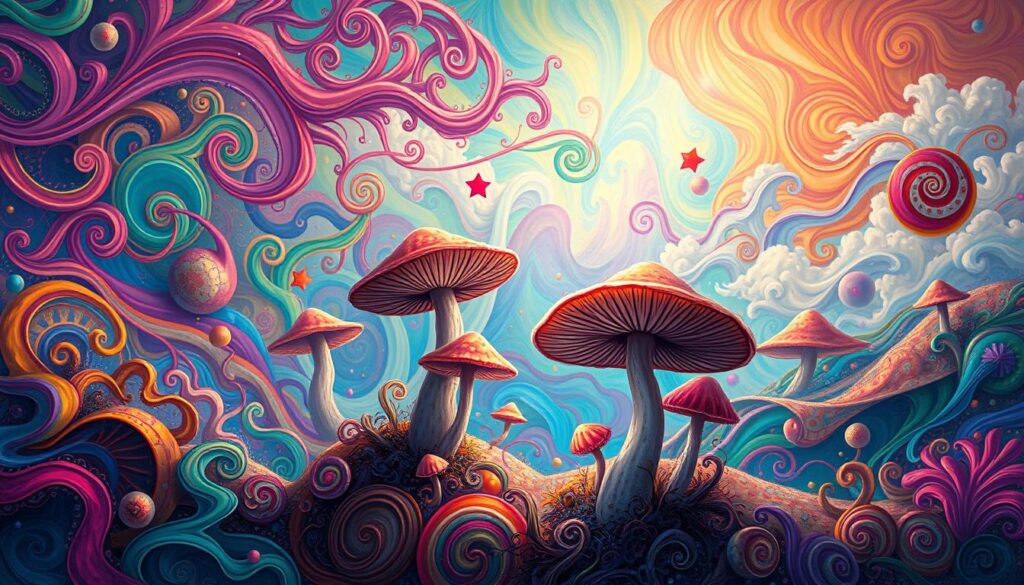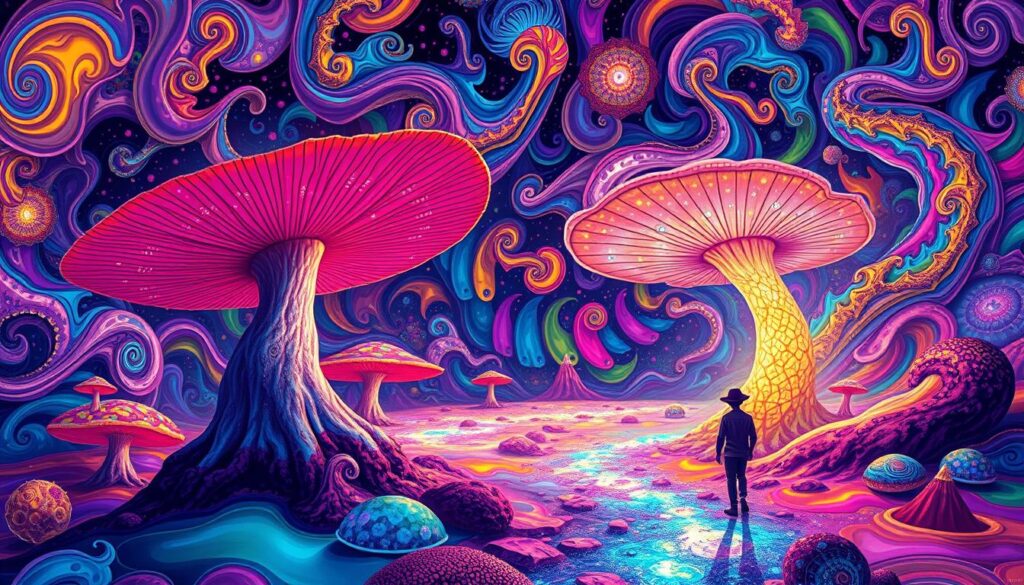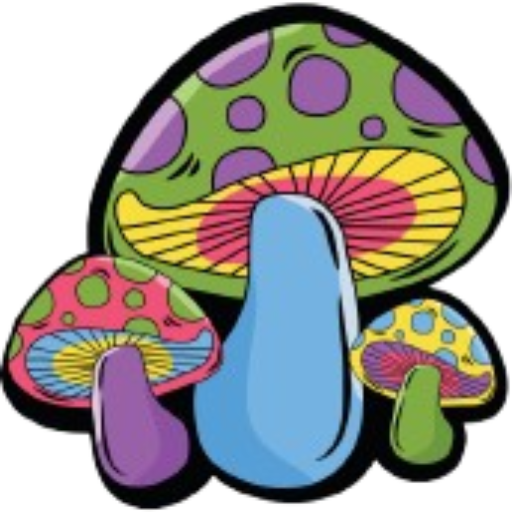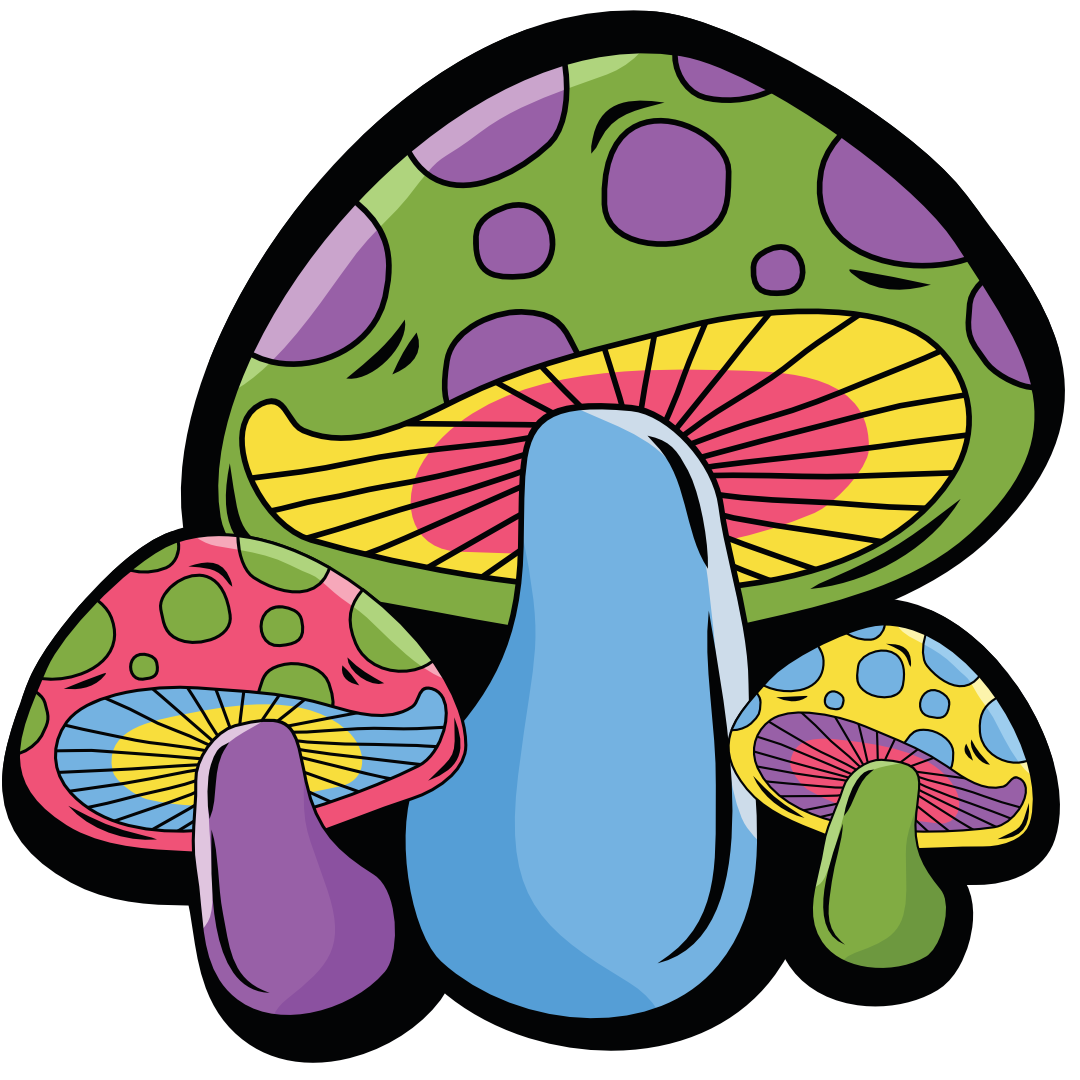Psychedelic mushrooms, with psilocybin, boost creativity and imagination. Artists and musicians like R. Crumb and Maya Hayuk say they’ve been inspired by these experiences. Studies now look into how psilocybin helps with creativity and thinking outside the box.
These mushrooms lead to new ways of seeing things and feeling. They can spark artistic ideas and improve problem-solving skills. People who use them often find they can think more freely and come up with new ideas.
Scientists are now really interested in how psychedelic mushrooms work. They’re looking into how these substances change our brains. This research could lead to new ways to use psychedelics for creativity and therapy.
Introduction to psychedelic mushrooms and creativity
For the last 60 years, scientists have looked into how psychedelic substances like psilocybin mushrooms boost creativity. This interest grew from stories by artists and musicians. They say psychedelics helped shape their work.
Anecdotal Evidence from Artists and Musicians
Artists like Adrian Piper and Yoko Ono have talked about using LSD or psilocybin mushrooms. They say these experiences greatly influenced their art. LSD pioneer Albert Hofmann even mentioned experiencing an “extremely stimulated imagination” after an LSD journey. Nobel-Prize-winning chemist Kary Mullis credited LSD for his invention of PCR. He said he could “watch polymers go by on a DNA molecule” thanks to his psychedelic experiences.
Recent Resurgence of Research on Psychedelics
Lately, there’s been a big push to study psychedelic substances for their therapeutic benefits. This includes looking into microdosing – taking small doses to improve thinking and creativity. Studies from the 1950s and ’60s show psychedelics can make art surreal. They also help in solving creative problems, often leading to breakthroughs.
“I saw colors and images I had never seen before. It was like a revelation – a whole new world opened up to me.” – Artist inspired by psychedelic experience
Psychedelic mushrooms and the “openness” trait
Recent studies have found a strong connection between psychedelic substances and the “openness” trait. This trait includes imagination, love for beauty, a desire to be different, and creativity. People who try psychedelic therapies often see a big boost in this area.
At the Imperial College London, researchers looked into how psilocybin affects people. They gave patients with depression small doses of psilocybin every week for three months. The results were amazing, showing a big jump in openness among the participants. This shows that psychedelics might help in many ways, not just treating depression.
At Leiden University, a study showed that people who took psychedelic truffles did better in creative thinking tests. This means they could solve problems in new and creative ways. It’s clear that psychedelics can help us think outside the box and be more creative.
There’s a growing interest in studying psychedelics again. This research could help us understand how to unlock our creative potential. As scientists learn more, we might see even more ways that these substances can help us grow and express ourselves.
Microdosing and creative problem-solving
Imagine a world where a small microdose of psychedelic mushrooms could unlock new creative potential. A study from Leiden University in the Netherlands found this to be true. Those who took a microdose of psychedelic truffles did better on tests of convergent and divergent thinking than a placebo group.
The researchers believe that a small amount of psychedelics leads to “unconstrained thought“. This state can boost creative problem-solving.
Creatives like Ryan Rosenthal, a designer at MUD\WTR, support psilocybin microdosing. They say it boosts creativity and productivity. Natasha Blake, a nail artist from London, also finds microdosing calming and expands her imagination.
While psilocybin’s long-term effects on the mind are debated, studies show it can harm cognitive skills and creativity right after use. But, some benefits were seen later. On the other hand, microdoses of psilocybin often improve creativity.

MUD\WTR CEO Shane Heath thinks it’s good to let people use substances that help their creativity and mental health. With psilocybin becoming legal in some places, exploring microdosing for better creative performance is exciting.
How psychedelic mushrooms enhance creativity and imagination
Psychedelic mushrooms are known for boosting creativity. Science is now uncovering how they do it. Two main reasons are thought to be behind this: the way they change our consciousness and how they alter our brain.
Altered States of Consciousness
Psychedelics change how we see things and feel about ourselves. They make us more open to new ideas. This can help us think creatively and see things in new ways.
Neuroplastic Changes in the Brain
Psychedelics, like psilocybin, boost a key protein for brain growth. This protein helps create new brain cells and strengthen connections. It’s all about making our brains more flexible and open to new ideas.
Together, these changes in consciousness and brain function make us more creative. As we learn more about psychedelics, we see their potential to unlock our creative sides.
Historical studies on psychedelics and creativity
In the 1950s and 60s, Oscar Janiger, a psychiatrist, led early studies on LSD’s impact on creativity. He worked with over 100 professional artists and 250 artworks. His goal was to see how psychedelic experiences could change the creative process.
A 1966 pilot study showed that psychedelic agents helped with creative problem-solving. But, a FDA ban stopped further research using normal human subjects.
In the 1990s, Terence McKenna also looked into the connection between psychedelics and creativity. These studies gave us valuable insights. But, they were limited by small sample sizes and different research methods.
Still, they opened the door for more research into psychedelic creativity. This could lead to new ways of solving problems and finding innovative solutions.
“Psychedelic drugs can produce profound changes in consciousness and perception, and these changes may facilitate certain types of creative thinking and problem-solving.”
As psychedelic research picked up again in the 21st century, scientists aimed to expand on these findings. They used modern neuroscience and cognitive tools to understand the link between psychedelic drugs and creative cognition. The idea that psychedelics could boost creativity is still being explored.
Artists inspired by psychedelic experiences
Many famous artists have been inspired by their psychedelic experiences. R. Crumb says LSD changed his art style. Maya Hayuk, from Brooklyn, uses psychedelics and other methods to create her paintings.
Psilocybin, found in magic mushrooms, helps with anxiety and depression. It boosts creativity. Celebrities like Seth Rogen and Kristen Bell use it for better art.
Artists like Alex Grey and Jake Holschuh use psychedelics in their work. They see psychedelics as tools for growth and creativity. Holschuh documents their use in sacred ceremonies.
David Normal combines psychedelics with meditation in his art. His work, like Cathenge, brings psychedelic visions to life. The Chapel of Sacred Mirrors in New York shows the link between psychedelics and art.
| Artist | Psychedelic Experience | Creative Output |
|---|---|---|
| R. Crumb | LSD | Transformed his cartoonist style |
| Maya Hayuk | Psychedelics, sleep deprivation, meditation | Vibrant, perception-shifting paintings |
| Alex Grey | Psychedelics | Visionary, psychedelic-inspired art |
| Victor-Jesus Escobedo | Psychedelics | Artwork exploring personal growth |
| Jake Holschuh | Psychedelics in sacred ceremonies | Documentation of psychedelic culture |
| Android Jones | Psychedelics | Imaginative, narrative-driven art |
| David Normal | Psychedelics, meditation | Immersive installations like Cathenge |
Psychedelics and creativity are closely linked. Artists find inspiration and growth in their experiences. As we learn more, art may show us the power of psychedelics.

Spontaneous vs. deliberative creative cognition
Recent studies have found two main types of creative thinking: spontaneous and deliberative. Psilocybin, found in psychedelic mushrooms, might slow down the deliberate kind of thinking. But, it can boost the spontaneous, free-flowing creativity.
Psilocybin’s Acute Effects on Creativity
Research shows that psilocybin can make people do worse on tests that need specific answers. Yet, users often say they feel more creative and imaginative when under its influence.
Long-term Effects on Creativity and Insight
But, the effects of psilocybin change over time. A week later, people can come up with more new ideas. This suggests psilocybin could help with creative thinking and solving problems in the long run. The short-term effects might hinder deliberate creativity, but the long-term effects seem to boost spontaneous, spontaneous creativity and insights.
“Psilocybin appears to unlock a more spontaneous and unfiltered form of creativity, which can lead to valuable insights and problem-solving abilities in the long run.”
Who uses psychedelics to enhance creativity?
Many high-achievers, from Nobel winners to tech innovators and athletes, say psychedelics boost their creativity and performance. Nobel Prize winners Francis Crick and Kary Mullis credited psychedelics for their big discoveries. Tech legend Steve Jobs called his LSD experience crucial to his life. Even top athletes like Super Bowl MVP Aaron Rodgers and pitcher Dock Ellis say psychedelics helped them get better.
Recent studies show psychedelics can really help with creativity. A 2021 study found psilocybin makes people think more creatively but less about tasks. Seven days later, they came up with more new ideas. A 2022 study showed LSD makes people more original and creative, but less organized.
In 2016, research found ayahuasca users were more creative and less focused on details. A 2018 study found microdosing psychedelic truffles made people more creative in both divergent and convergent thinking.
| Study | Findings |
|---|---|
| Mason et al. (2021) | Psilocybin increased spontaneous creative insights, decreased deliberate task-based creativity, and increased novel ideas 7 days after intake. |
| Wiebner et al. (2022) | LSD consumption led to heightened originality and symbolic thinking, while reducing organization in tasks. |
| Kuypers et al. (2016) | Ayahuasca users experienced heightened creative divergent thinking and decreased convergent thinking. |
| Randomized study (2018) | Microdosing psychedelic truffles increased both divergent and convergent thinking. |
Studies show psychedelics can really boost creative thinking. They help people see things differently, break barriers, and get more done. This leads to more ideas and inspiration.
Mechanisms of action: Altered states and neuroplasticity
Psychedelic medicines boost creativity in two main ways. They create new states of consciousness and change the brain’s structure. These changes help in thinking outside the box and finding new ideas.
They also increase brain-derived neurotrophic factor (BDNF). This factor helps grow new brain cells and connections. These are key for learning, remembering, and solving problems creatively. Scientist David Olson calls these medicines “psychoplastogens” because of their brain-changing effects.
Psychedelics work differently in humans than in other animals. Studies show they cause spiritual experiences by changing the brain. Researchers use special tests to measure these changes in consciousness.
The way psychedelics work involves unlocking the brain’s hidden abilities. This is done through the mirror neuron system. Even after the drug’s effects wear off, some changes can last. Brain scans suggest these changes can affect how we see the world and ourselves.
“Psychedelics reliably elicit experiences that closely resemble mystical experiences induced through prolonged austerities and disciplined contemplative practice.”
Bringing psychedelics back into science opens up new ways to study the brain. Changes in brain connections can lead to different experiences. This includes feeling out of body, spiritual moments, and increased self-awareness.
Future directions and plant intelligence
Research into psychedelics and creativity is growing. One area to explore is the intelligence of psychedelic plants. Associate Professor Monica Gagliano at Southern Cross University in Australia has found that plants are smarter than we thought.
Her studies show plants can feel their surroundings, talk to each other, do math, remember, and make choices. This means psychedelic plants could teach us a lot about thinking and being creative. By studying these plants, we might learn how to boost our own creativity.
“Plants can sense their environment, communicate with each other, perform mathematical computations, remember, and make decisions.”
The study of plant intelligence and psychedelic plants is a new and exciting area. It connects creativity, the human mind, and nature. The work of Monica Gagliano could lead to new ways of understanding plant communication and plant decision-making.
Looking into plant intelligence could help us find new ways to be more creative and solve problems. This field is set to reveal new and important insights. It will show us more about the amazing abilities of the natural world.
Conclusion
Psychedelic mushrooms, with their active compound psilocybin, have long been linked to creativity and imagination. Artists and musicians share stories of how these mushrooms enhance their work. Recent studies also back this up, showing that they can boost creative thinking and problem-solving.
This happens because psychedelics change how we think and feel. They also help our brains adapt and change. This is key to unlocking new ideas and solutions.
While the idea of using psychedelics for creativity is exciting, we need to know more. The long-term effects are still a mystery. But, research is growing, with places like Johns Hopkins leading the way.
This research is a big step towards understanding how psychedelics work. It helps us see how they can change our minds and creativity. It’s a promising area of study.
Looking into psychedelic plants could teach us a lot about creativity and intelligence. By studying them carefully, we might discover new ways to think and create. This could lead to big breakthroughs in how we understand our minds and creativity.

